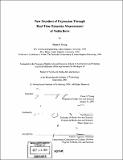| dc.contributor.advisor | Tod Machover. | en_US |
| dc.contributor.author | Young, Diana S. (Diana Santos), 1975- | en_US |
| dc.contributor.other | Massachusetts Institute of Technology. Dept. of Architecture. Program In Media Arts and Sciences. | en_US |
| dc.date.accessioned | 2011-06-06T17:42:09Z | |
| dc.date.available | 2011-06-06T17:42:09Z | |
| dc.date.copyright | 2001 | en_US |
| dc.date.issued | 2001 | en_US |
| dc.identifier.uri | http://hdl.handle.net/1721.1/63219 | |
| dc.description | Thesis (S.M.)--Massachusetts Institute of Technology, School of Architecture and Planning, Program in Media Arts and Sciences, 2001. | en_US |
| dc.description | Includes bibliographical references (leaves 84-87). | en_US |
| dc.description.abstract | The violin has long been admired as one of the most beautiful, complex, and challenging musical instruments. With its capacity for nuance, richness of tone, and flexibility of range, its expressive qualities have been surpassed by none, despite the fact that its construction has not been changed for hundreds of years. It is the form and function of the traditional violin that inspired the work detailed in this thesis. Here, the design and construction of a new violin interface, the Hyperbow, is discussed. The motivation driving the research of this instrument was the desire to create a violin bow capable of measuring the most intricate aspects of violin technique, the subtle elements of physical gesture that immediately and directly impact the sound of the instrument while playing. In order to provide this insight into the subtleties of bow articulation, a sensing system was implemented to measure changes in position, acceleration, and the downward and lateral strains on the bow stick. These sensors were fashioned using an electromagnetic field sensing technique, commercial MEMS accelerometers, and foil strain gauges. Because the forces and stresses applied to the bow are immediately connected to a violinist's experience while playing, the implementation of a new music controller that utilizes these intimate aspects of physical interaction between a player and an instrument may inspire altogether new methods of expression. The measurement techniques used in this work were found to be quite sensitive and yielded sensors that were easily controllable by a player using traditional right hand bowing technique. In addition, the Hyperbow proved to be helpful in recognizing and analyzing the physical parameters of common bowstrokes | en_US |
| dc.description.statementofresponsibility | by Diana S. Young. | en_US |
| dc.format.extent | 87 leaves | en_US |
| dc.language.iso | eng | en_US |
| dc.publisher | Massachusetts Institute of Technology | en_US |
| dc.rights | M.I.T. theses are protected by
copyright. They may be viewed from this source for any purpose, but
reproduction or distribution in any format is prohibited without written
permission. See provided URL for inquiries about permission. | en_US |
| dc.rights.uri | http://dspace.mit.edu/handle/1721.1/7582 | en_US |
| dc.subject | Architecture. Program In Media Arts and Sciences. | en_US |
| dc.title | New frontiers of expression through real-time dynamics measurement of violin bows | en_US |
| dc.type | Thesis | en_US |
| dc.description.degree | S.M. | en_US |
| dc.contributor.department | Program in Media Arts and Sciences (Massachusetts Institute of Technology) | |
| dc.identifier.oclc | 50396886 | en_US |
